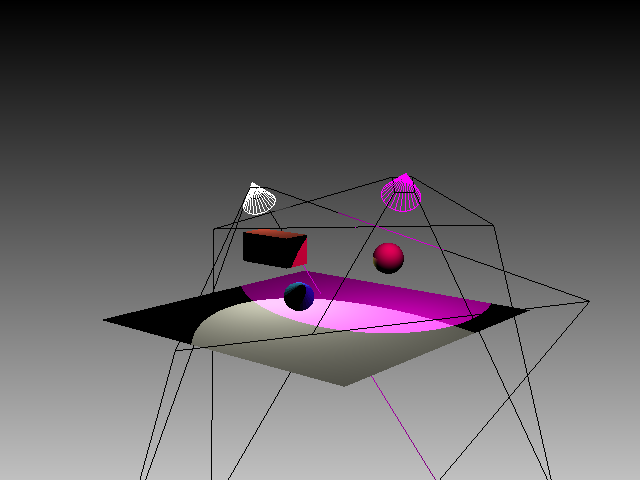ShadowsLightsDemo
Repository source: ShadowsLightsDemo
Other languages
See (Python), (PythonicAPI)
Question
If you have a question about this example, please use the VTK Discourse Forum
Code¶
ShadowsLightsDemo.cxx
// The scene consists of:
// 1) four actors: a rectangle, a box, a cone and a sphere.
// The box, the cone and the sphere are above the rectangle.
// 2) Two spotlights, one in the direction of the box, another one in the
// direction of the sphere.
// Both lights are above the box, the cone and the sphere.
#include <vtkActor.h>
#include <vtkCamera.h>
#include <vtkCameraPass.h>
#include <vtkConeSource.h>
#include <vtkCubeSource.h>
#include <vtkLight.h>
#include <vtkLightActor.h>
#include <vtkLightCollection.h>
#include <vtkNamedColors.h>
#include <vtkNew.h>
#include <vtkOpaquePass.h>
#include <vtkOpenGLRenderer.h>
#include <vtkPlaneSource.h>
#include <vtkPointData.h>
#include <vtkPolyDataMapper.h>
#include <vtkPolyDataNormals.h>
#include <vtkProperty.h>
#include <vtkRenderPassCollection.h>
#include <vtkRenderWindow.h>
#include <vtkRenderWindowInteractor.h>
#include <vtkSequencePass.h>
#include <vtkShadowMapBakerPass.h>
#include <vtkShadowMapPass.h>
#include <vtkSphereSource.h>
namespace {
// For each spotlight, add a light frustum wireframe representation and a cone
// wireframe representation, colored with the light color.
void AddLightActors(vtkRenderer* r);
} // namespace
int main(int, char*[])
{
vtkNew<vtkRenderWindowInteractor> interactor;
vtkNew<vtkRenderWindow> renderWindow;
renderWindow->SetSize(400, 400);
renderWindow->SetMultiSamples(0);
renderWindow->SetAlphaBitPlanes(1);
interactor->SetRenderWindow(renderWindow);
vtkNew<vtkOpenGLRenderer> renderer;
renderWindow->AddRenderer(renderer);
renderWindow->SetSize(640, 480);
vtkNew<vtkSequencePass> seq;
vtkNew<vtkRenderPassCollection> passes;
vtkNew<vtkShadowMapPass> shadows;
passes->AddItem(shadows->GetShadowMapBakerPass());
passes->AddItem(shadows);
vtkNew<vtkOpaquePass> opaque;
passes->AddItem(opaque);
seq->SetPasses(passes);
vtkNew<vtkCameraPass> cameraP;
cameraP->SetDelegatePass(seq);
// Tell the renderer to use our render pass pipeline.
vtkOpenGLRenderer* glrenderer =
dynamic_cast<vtkOpenGLRenderer*>(renderer.GetPointer());
glrenderer->SetPass(cameraP);
vtkNew<vtkNamedColors> colors;
vtkColor3d boxColor = colors->GetColor3d("Tomato");
vtkColor3d rectangleColor = colors->GetColor3d("Beige");
vtkColor3d coneColor = colors->GetColor3d("Peacock");
vtkColor3d sphereColor = colors->GetColor3d("Banana");
vtkNew<vtkPlaneSource> rectangleSource;
rectangleSource->SetOrigin(-5.0, 0.0, 5.0);
rectangleSource->SetPoint1(5.0, 0.0, 5.0);
rectangleSource->SetPoint2(-5.0, 0.0, -5.0);
rectangleSource->SetResolution(100, 100);
vtkNew<vtkPolyDataMapper> rectangleMapper;
rectangleMapper->SetInputConnection(rectangleSource->GetOutputPort());
rectangleMapper->SetScalarVisibility(0);
vtkNew<vtkActor> rectangleActor;
rectangleActor->SetMapper(rectangleMapper);
rectangleActor->SetVisibility(1);
rectangleActor->GetProperty()->SetColor(rectangleColor.GetData());
vtkNew<vtkCubeSource> boxSource;
boxSource->SetXLength(2.0);
vtkNew<vtkPolyDataNormals> boxNormals;
boxNormals->SetInputConnection(boxSource->GetOutputPort());
boxNormals->ComputePointNormalsOff();
boxNormals->ComputeCellNormalsOn();
boxNormals->Update();
boxNormals->GetOutput()->GetPointData()->SetNormals(nullptr);
vtkNew<vtkPolyDataMapper> boxMapper;
boxMapper->SetInputConnection(boxNormals->GetOutputPort());
boxMapper->SetScalarVisibility(0);
vtkNew<vtkActor> boxActor;
boxActor->SetMapper(boxMapper);
boxActor->SetVisibility(1);
boxActor->SetPosition(-2.0, 2.0, 0.0);
boxActor->GetProperty()->SetColor(boxColor.GetData());
vtkNew<vtkConeSource> coneSource;
coneSource->SetResolution(24);
coneSource->SetDirection(1.0, 1.0, 1.0);
vtkNew<vtkPolyDataMapper> coneMapper;
coneMapper->SetInputConnection(coneSource->GetOutputPort());
coneMapper->ScalarVisibilityOff();
vtkNew<vtkActor> coneActor;
coneActor->SetMapper(coneMapper);
coneActor->VisibilityOn();
coneActor->SetPosition(0.0, 1.0, 1.0);
coneActor->GetProperty()->SetColor(coneColor.GetData());
vtkNew<vtkSphereSource> sphereSource;
sphereSource->SetThetaResolution(32);
sphereSource->SetPhiResolution(32);
vtkNew<vtkPolyDataMapper> sphereMapper;
sphereMapper->SetInputConnection(sphereSource->GetOutputPort());
sphereMapper->ScalarVisibilityOff();
vtkNew<vtkActor> sphereActor;
sphereActor->SetMapper(sphereMapper);
sphereActor->VisibilityOn();
sphereActor->SetPosition(2.0, 2.0, -1.0);
sphereActor->GetProperty()->SetColor(sphereColor.GetData());
renderer->AddViewProp(rectangleActor);
renderer->AddViewProp(boxActor);
renderer->AddViewProp(coneActor);
renderer->AddViewProp(sphereActor);
// Spotlights.
// Lighting the box.
vtkNew<vtkLight> l1;
l1->SetPosition(-4.0, 4.0, -1.0);
l1->SetFocalPoint(boxActor->GetPosition());
l1->SetColor(colors->GetColor3d("White").GetData());
l1->PositionalOn();
renderer->AddLight(l1);
l1->SwitchOn();
// Lighting the sphere.
vtkNew<vtkLight> l2;
l2->SetPosition(4.0, 5.0, 1.0);
l2->SetFocalPoint(sphereActor->GetPosition());
l2->SetColor(colors->GetColor3d("Magenta").GetData());
l2->PositionalOn();
renderer->AddLight(l2);
l2->SwitchOn();
AddLightActors(renderer);
renderer->SetBackground2(colors->GetColor3d("Black").GetData());
renderer->SetBackground(colors->GetColor3d("Silver").GetData());
renderer->SetGradientBackground(true);
renderWindow->Render();
renderWindow->SetWindowName("ShadowsLightsDemo");
renderer->ResetCamera();
auto camera = renderer->GetActiveCamera();
camera->Azimuth(40.0);
camera->Elevation(10.0);
renderWindow->Render();
interactor->Start();
return EXIT_SUCCESS;
}
namespace {
// For each spotlight, add a light frustum wireframe representation and a cone
// wireframe representation, colored with the light color.
void AddLightActors(vtkRenderer* r)
{
vtkLightCollection* lights = r->GetLights();
lights->InitTraversal();
vtkLight* light = lights->GetNextItem();
while (light != 0)
{
double angle = light->GetConeAngle();
if (light->LightTypeIsSceneLight() && light->GetPositional() &&
angle < 180.0) // spotlight
{
vtkNew<vtkLightActor> light_actor;
light_actor->SetLight(light);
r->AddViewProp(light_actor);
}
light = lights->GetNextItem();
}
}
} // namespace
CMakeLists.txt¶
cmake_minimum_required(VERSION 3.12 FATAL_ERROR)
project(ShadowsLightsDemo)
find_package(VTK COMPONENTS
CommonColor
CommonCore
CommonDataModel
FiltersCore
FiltersSources
InteractionStyle
RenderingContextOpenGL2
RenderingCore
RenderingFreeType
RenderingGL2PSOpenGL2
RenderingOpenGL2
)
if (NOT VTK_FOUND)
message(FATAL_ERROR "ShadowsLightsDemo: Unable to find the VTK build folder.")
endif()
# Prevent a "command line is too long" failure in Windows.
set(CMAKE_NINJA_FORCE_RESPONSE_FILE "ON" CACHE BOOL "Force Ninja to use response files.")
add_executable(ShadowsLightsDemo MACOSX_BUNDLE ShadowsLightsDemo.cxx )
target_link_libraries(ShadowsLightsDemo PRIVATE ${VTK_LIBRARIES}
)
# vtk_module_autoinit is needed
vtk_module_autoinit(
TARGETS ShadowsLightsDemo
MODULES ${VTK_LIBRARIES}
)
Download and Build ShadowsLightsDemo¶
Click here to download ShadowsLightsDemo and its CMakeLists.txt file. Once the tarball ShadowsLightsDemo.tar has been downloaded and extracted,
cd ShadowsLightsDemo/build
If VTK is installed:
cmake ..
If VTK is not installed but compiled on your system, you will need to specify the path to your VTK build:
cmake -DVTK_DIR:PATH=/home/me/vtk_build ..
Build the project:
make
and run it:
./ShadowsLightsDemo
WINDOWS USERS
Be sure to add the VTK bin directory to your path. This will resolve the VTK dll's at run time.
